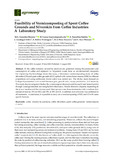Mostrar el registro sencillo del ítem
Feasibility of vermicomposting of spent coffee grounds and silverskin from coffee industries: a laboratory study
| dc.creator | González Moreno, Miguel Ángel | es_ES |
| dc.creator | Marcelino Sádaba, Sara | es_ES |
| dc.creator | Zaratiegui Urdin, Javier | es_ES |
| dc.creator | Robles Domínguez, Estrella | es_ES |
| dc.creator | Pérez Ezcurdia, Amaya | es_ES |
| dc.creator | Seco Meneses, Andrés | es_ES |
| dc.date.accessioned | 2021-01-11T11:43:52Z | |
| dc.date.available | 2021-01-11T11:43:52Z | |
| dc.date.issued | 2020 | |
| dc.identifier.issn | 2073-4395 | |
| dc.identifier.uri | https://hdl.handle.net/2454/38980 | |
| dc.description.abstract | In the coffee industry, several by-products are generated during the production and consumption of coffee and represent an important waste from an environmental viewpoint. For improving the knowledge about this issue, a laboratory vermicomposting study of coffee silverskin (CS) and spent coffee grounds (SCG) spiked with mature horse manure (HM) in different proportions and using earthwormEisenia andreiwas carried out. The 60-day study focused on biological parameters such as total biomass gain, growth rate, cocoon production, and mortality. This study also investigated whether the vermicompost obtained could be useful and lacked toxicity through a seed germination test using hybrid wheat seeds. Results showed a disparity depending on the type of residue and the mixture used. Best options were those treatments with a medium-low amount of residue; 25% for SCG and 25% or 50% for CS. In addition, lack of toxicity was confirmed in all treatments. In conclusion, it is possible to carry out a vermicomposting of SCG and CS with some specific features. | en |
| dc.description.sponsorship | This research was funded by Government of Navarre and European Regional Development Fund (ERDF) grant number VERMICOMPOSTAJE 4.0—VERMIOT (0011-1365-2019-000110), research project. The APC was funded by Fundación Euskoiker. | en |
| dc.format.extent | 15 p. | |
| dc.format.mimetype | application/pdf | en |
| dc.language.iso | eng | en |
| dc.publisher | MDPI | en |
| dc.relation.ispartof | Agronomy, 2020, 10(8):1125 | en |
| dc.rights | © 2020 by the author. Licensee MDPI, Basel, Switzerland. This article is an open access article distributed under the terms and conditions of the Creative Commons Attribution (CC BY) license. | en |
| dc.rights.uri | http://creativecommons.org/licenses/by/4.0/ | |
| dc.subject | Coffee industry by-products | en |
| dc.subject | Coffee silverskin | en |
| dc.subject | Spent coffee grounds | en |
| dc.subject | Vermicompost | en |
| dc.subject | E. andrei | en |
| dc.title | Feasibility of vermicomposting of spent coffee grounds and silverskin from coffee industries: a laboratory study | en |
| dc.type | info:eu-repo/semantics/article | en |
| dc.type | Artículo / Artikulua | es |
| dc.contributor.department | Ingeniería | es_ES |
| dc.contributor.department | Ingeniaritza | eu |
| dc.contributor.department | Institute of Smart Cities - ISC | es_ES |
| dc.rights.accessRights | info:eu-repo/semantics/openAccess | en |
| dc.rights.accessRights | Acceso abierto / Sarbide irekia | es |
| dc.identifier.doi | 10.3390/agronomy10081125 | |
| dc.relation.publisherversion | https://doi.org/10.3390/agronomy10081125 | |
| dc.type.version | info:eu-repo/semantics/publishedVersion | en |
| dc.type.version | Versión publicada / Argitaratu den bertsioa | es |
| dc.contributor.funder | Gobierno de Navarra / Nafarroako Gobernua, VERMICOMPOSTAJE 4.0-VERMIOT (0011-1365-2019-000110) | es |






